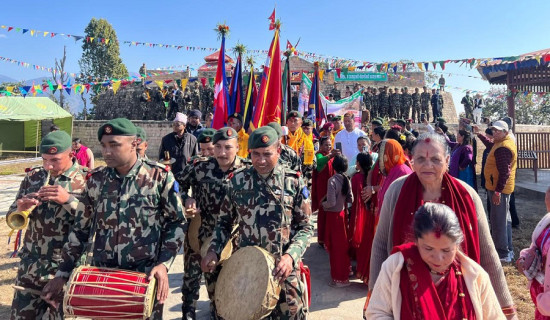- Thursday, 8 January 2026
Monsoon Calls For Swift Preparatory Measures
The monsoon season is upon us as rain clouds entered the country from the eastern border three days prior to its usual arrival on June 13. During this season, the Nepali people feel both delight and an unpredictable level of fright. Indeed, the monsoon rains are the lifeblood of Nepal's agriculture, in which around 65 per cent of the population is engaged for both sustenance and livelihoods. The timely arrival of monsoons increases the likelihood of optimal crop production, including rice, maize, and millet, and protects millions of farmers' livelihoods while also strengthening the country's food security. The rains that fall between June and the second week of October replenish groundwater supplies, fill reservoirs, and maintain rivers that are vital for agriculture and hydropower generation.
The monsoon not only provides possibilities for agro-products and hydropower production, but it also rejuvenates Nepal's rich biodiversity. The country's forests, which cover around 40 per cent of the area, flourish at this time because the rainy season supports a diverse range of plants and wildlife. Meanwhile, the lush forests serve an important role in carbon sequestration and help reduce the effects of climate change. However, monsoon downpours are both a blessing and a burden for Nepali people.
While monsoon rains offer hope to Nepal's parched crops, forests, and people, they also cause a great deal of anxiety among Nepalis. During this season, natural catastrophes such as floods, landslides, soil erosion, property devastation, loss of life, displacement, and forced relocation make headlines. Many calamities strike without warning, resulting in the loss of lives and public and private property. Landslides in hilly locations bury families and individuals, while flooded rivers cause damage to private and public property and kill people.
Floods, landslides, inundations
Floods, landslides, and inundations displace people and put them into poverty, exacerbating their vulnerability and having a significant socioeconomic impact. According to Home Ministry data, rain-related disasters have killed approximately 5,000 people over the last two decades, with another 2,000 missing. Monsoon rains are expected to arrive in Nepal by the start of June and last until the second week of October, with meteorologists anticipating higher-than-average rainfall this year.
This year's monsoon rains, like those in past years, will undoubtedly wreak havoc on many parts of the nation, impacting a large portion of the population. The National Disaster Risk Reduction and Management Authority (NDRRMA) predicts that floods and landslides may affect 1.8 million people in 412,000 households during this period, while 83,000 residences may be directly affected, and 18,000 families will need rescue and assistance.
When it comes to rescue and aid, this is a large number, which could consume significant government resources. As this year's rainy season arrives earlier than normal in Nepal, the Department of Hydrology and Meteorology has predicted 35 to 55 percent above-average rainfall. As a result, rain-related damages and tragedies cannot be avoided, but the dangers and bad effects may be mitigated by taking prior action. It is important to always be prepared, while authorities must remain aware that a disaster might occur at any time and in any location during the rainy season. It is highly necessary for the quick mobilisation of specialist task teams to manage and mitigate the effects of rain-related disasters in countries such as Nepal, where delivering timely rescue becomes a difficult job due to the country's terrain and unfavourable weather.
According to media reports, the government has taken substantial steps to bring together NGOs and other government organisations to better plan for and react to monsoon catastrophes on a national and regional scale. Since 2003, there have been national campaigns to prepare for, mitigate, and prevent monsoon consequences. The Ministry of Home Affairs launched the coordinated approach with the publication of the 'Monsoon Flood Preparedness and Response Plan Construction Guidelines', which were complemented by the 'Risk Management National Strategy, 2009'. The 'Preparation and Response National Action Plan, 2024', published by the NDRRMA under the Ministry of Home Affairs, has recently been amended to make it more effective in mobilisation, rescue, and rehabilitation efforts.
During rainy periods, Nepal's mountainous rivers, such as the Koshi, Karnali, and others, become more dangerous for people living in mountains, hills, and Terai plains as swollen rivers damage infrastructure such as highways, roads, electricity supply lines, office buildings, and, especially in plain areas, inundated farm fields and people's homes, forcing many of them to relocate. The NDRRMA has planned to stay vigilant in rescue and relief efforts, especially for vulnerable families.
According to government sources, more than 31,000 security troops from the Nepal Army, Armed Police Force, and Nepal Police are ready to be deployed to rescue, rehabilitate, and assist those affected by monsoon-related calamities. Furthermore, the Ministry of Home Affairs has established a command centre to manage disaster mitigation, rescue, and relief actions connected to monsoons. Helicopters, heavy machinery, and dozers will be deployed to rescue stranded and affected people and to clear blocked roadways, respectively, while bay bridges may be created immediately in the event of highway bridge damage. Relief supplies will be delivered quickly to any disaster-affected area. Many Terai and hill areas are in danger this year, as the monsoon prediction suggests above-average rainfall throughout the country.
Adverse climate impacts
The increase in temperature, lopsided rain patterns, long dry spells, and other weather phenomena hint that Nepal has suffered bad impacts from climate change. With the nation witnessing some severe consequences of climate change, scientists estimate that the frequency of floods and landslides has increased considerably in recent years. These disasters cost the government an estimated 3 billion rupees per year. Effective disaster management encompasses more than just post-event responses. To deal with disasters effectively, early warning systems and preventive measures are essential. This year, the NDRRMA has taken early action by releasing the Monsoon Preparedness and Response National Action Plan, 2024, which outlines the duties of federal ministries, authorities, departments, security agencies, state governments, districts, and municipalities. Many have hoped that these early preparations may work to lessen the harsh consequences of rain-triggered calamities.
The Department of Hydrology and Meteorology, in collaboration with two major national telecom carriers, has also planned for swift flood information dissemination. However, experts point out that the current disaster management system has some flaws. According to reports, provincial and municipal disaster management committees lack the necessary authority and resources to respond correctly to calamities and their impacts. Furthermore, people's local-level representatives, including mayors, deputy mayors, and ward presidents, who should be involved in mitigating the effects of natural catastrophes in the local areas, lack the authority and knowledge to deal with the problem.
Though floods, landslides, and other natural disasters are a part of the lives of many Nepalis, with careful planning and prevention measures, their impacts may be reduced to a tolerable level. The government's recent efforts to design and implement a national action plan are praiseworthy, but much more needs to be done. Empowering disaster management authorities, improving early warning systems, and ensuring coordinated response activities at all levels of government are critical steps towards mitigating the devastating consequences of these natural catastrophes. It is really heartening to see many lawmakers in our parliament raise the issue of early preparation efforts to deal with the bad impacts of the rainy period.
As the impacts of monsoon season start taking toll, it is critical that all stakeholders move quickly and decisively to protect lives, public infrastructure such as highways, roads, bridges, electricity lines, and, most importantly, people's properties and livelihoods. Whenever the monsoon season arrives, people start living in continual anxiety because of our lack of preparedness and timely response to dealing with emergencies, which exacerbates the threats posed by the rain-triggered calamitous events.
(Upadhyay is the former managing editor of this daily.)

















